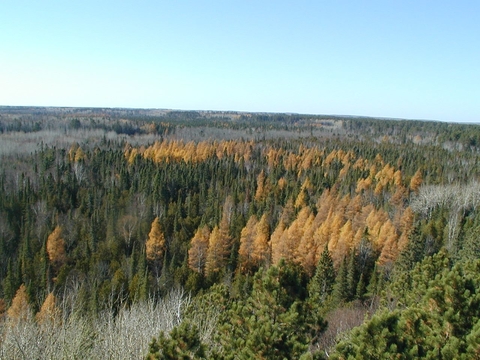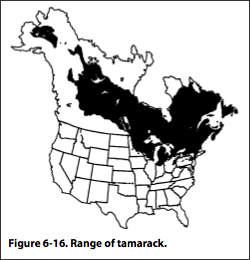Quick facts
- Tamarack is commonly found on bogs or peatlands.
- There is little economic impact from tamarack harvesting.
- Common pests to tamarack trees include larch sawfly, eastern larch beetle, root and heart rots, and porcupines.
Managing tamarack forests
Tamarack (also known as eastern larch) is used for pulp, poles and lumber, although it has relatively minor economic importance.
You’ll find red squirrel, snowshoe hare and porcupine in tamarack stands. Tamarack is habitat for many songbirds and a critical habitat for the great gray owl and its small mammal prey species.
Growing conditions
You can find tamarack in pure stands, but it’s more common in mixed stands, primarily with black spruce. You’ll also find tamarack mixed with northern white cedar, black ash, red maple, eastern white pine and/or paper birch.
Tamarack commonly grows on bogs or peatland where the organic soil or peat is more than 12 inches thick. You’ll find tamarack on a wide range of peatlands, but it’s usually found in poor swamps where soil water is weakly enriched with mineral nutrients.
The best sites are:
- Upland sites.
- Moist, well-drained loamy soils along streams, lakes or swamps.
- Mineral soils with a shallow surface layer of organic matter.
Competition from more shade-tolerant species often quickly eliminates tamarack from these sites. Because of this, we find tamarack in Minnesota wetlands that other species don’t tolerate. While tamarack can tolerate wet sites, it won’t survive prolonged flooding.
Regenerating tamarack
The regeneration system advised for tamarack combines clearing and seed-tree with natural seeding. Good seed years occur every three to six years starting when trees are about 40 years old.
A rotation is the number of years required to establish and grow trees to a desired size, product or maturity.
Depending on the site location and characteristics, tamarack will produce timber that’s fit to be sold on a rotation between 40 and 90 years.
- The best seedbed is a warm, moist mineral or organic soil with no brush, but a light cover of grass or other herbaceous vegetation.
- Hummocks of slow-growing sphagnum moss often make a good seedbed.
- Most seed falls within 200 feet of the seed tree.
Orient harvest strips so they’re perpendicular to the wind. They can be up to 200 feet wide.
After clearing the first strip, wait about 10 years or until the area is well-stocked with seedlings. Then, clear a second strip adjacent to the first and on the windward side. Again, wait until regeneration is established, then use the seed-tree method to cut the remaining strip.
The seed-tree cut should leave about 10 well-spaced dominant tamaracks per acre. Once the regenerated trees have been established, harvest or kill seed trees. This eliminates competition and possible disease hosts.
To ensure tamarack can regenerate, you may need to prepare the site following a harvest. Broadcast burn mixed-species stands to remove the branches and treetops left on the ground (known as slash).
Tamarack slash doesn’t burn well. So to remove it, harvest pure tamarack stands by full-tree skidding — meaning, cut the trees and then transport them with their branches and top intact. Then, treat the brush with herbicides. Alternatively, you could pile and burn the slash or shear or chop the brush.
Tamarack seedlings need abundant light and constant moisture. Seedlings established under a fully stocked stand won’t survive beyond the sixth year.
Early seedling losses are caused by damping-off fungus, drought, flooding, inadequate light and snowshoe hares. Given enough light, tamarack is one of the fastest-growing conifers on upland sites.
Intermediate treatments
Thinning is only economically feasible on good sites when the goal is to produce poles or sawtimber.
If a market exists for small products such as posts or pulpwood, cut and sell the trees as soon as the stand can produce these products. This approach is known as commercial thinning.
Additional periodic thinnings are recommended up to 20 years before the end of the rotation. Each thinning should leave a basal area of 80 to 90 square feet per acre. Basal area measures stand density using the sum of trees’ cross-sectional areas at 4.5 feet from the ground (known as breast height).
Pest management
The larch sawfly is a serious insect pest of tamarack. After several years of defoliation, the sawfly can stress and eventually kill a tree.
Many forms of chemical control are available. Depending on the outbreak’s severity, you may need these to manage sawfly populations.
There aren't any changes you can make to the natural environment to control sawflies. But, as with all defoliating insects, it’s important to maintain healthy trees to minimize the stress caused by defoliation.
The eastern larch beetle is a native bark beetle that has infested considerable forests across northern Minnesota.
To minimize damage, encourage a mix of tree species and ages.
- This reduces how many host trees are available.
- Makes it harder for the pests to get needed resources.
- Limits the beetle’s ability to survive and spread.
Eastern larch beetles don’t typically attack seedlings and saplings.
Tamarack is susceptible to root and heart rots. You can minimize rots if you avoid damaging the base and roots of trees during intermediate cuttings.
Porcupines can cause extensive damage to tamaracks by feeding on the main stem’s bark.
Reviewed in 2018




